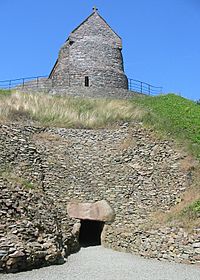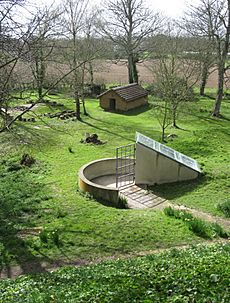La Hougue Bie facts for kids
 |
|
| Public transit access | Bus route 13 |
|---|---|
| Nearest car park | On site (no charge) |
La Hougue Bie is an amazing historic site and museum on the island of Jersey. It's located in the parish of Grouville. This special place is even shown on the 2010 Jersey 1 pound note! It holds secrets from thousands of years ago, right up to more recent history.
Contents
Discovering La Hougue Bie: An Ancient Mystery
La Hougue Bie is one of the largest and best-preserved ancient burial sites in Western Europe. It's a fantastic place to learn about how people lived long, long ago.
What's in a Name?
The name "La Hougue Bie" has a cool history. "Hougue" comes from an old Norse word meaning "mound" or "heap." This makes sense because the site is a big earth mound! The meaning of "Bie" is a bit of a mystery. Some people think it might be linked to an old legend. Others believe it could mean "a building on the earth mound."
Journey into the Past: The Passage Grave
Imagine a huge tunnel and chamber built over 5,500 years ago! That's what you'll find at La Hougue Bie. It's a 20.4-meter long passage leading to a chamber, all covered by a 12.2-meter high earth mound. This type of structure is called a passage grave.
Archaeologists first explored the site in 1925. They found pieces of pottery and the remains of at least eight people. These sites were not just for burials. They were important ceremonial places, like ancient churches or cathedrals.
Sun's Secrets: Equinox Alignment
Something truly special happens inside the passage grave. On the March equinox (around March 20th) and the September equinox (around September 22nd), the sun's rays shine all the way through the passage. They light up the back of the chamber! This amazing alignment might have been a happy accident, but it makes the site even more magical.
Chapels and Towers Through Time
Over the centuries, new buildings were added on top of the ancient mound. Two medieval chapels were built there. One is from the 12th century and the other from the 16th century.
Later, in 1792, a building called the Prince’s Tower was started. It was meant to be a signal station. However, this tower was taken down in 1924. The site has changed a lot over its long history!
A Wartime Lookout Point
During the Second World War, La Hougue Bie played an important role. It was used as a key lookout point. An underground command bunker was built inside the mound and nearby. Today, you can explore this bunker. It has an exhibition that tells the story of the workers who were forced to build defenses on Jersey during the German occupation.
Exploring the Museum Today
Today, La Hougue Bie is managed by Jersey Heritage. It's home to a fantastic archaeology exhibit. You can see the "Unearthing Le Câtillon II" display. This exhibit showcases the Grouville Hoard, which is the world's largest collection of Celtic coins! Visitors can learn why people might have buried 70,000 coins and jewelry in Jersey 2,000 years ago. It's like a real-life treasure hunt!
See also


